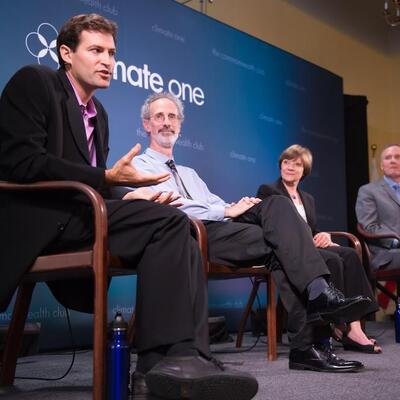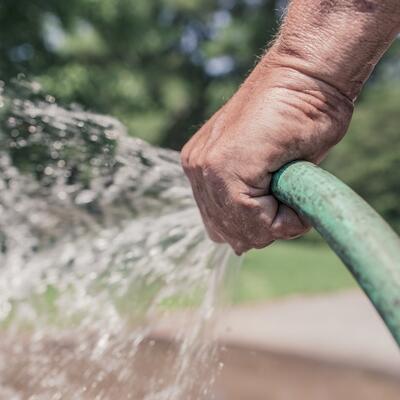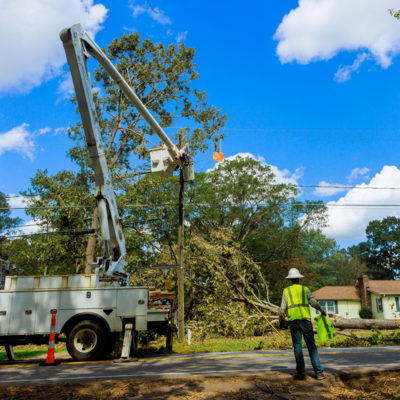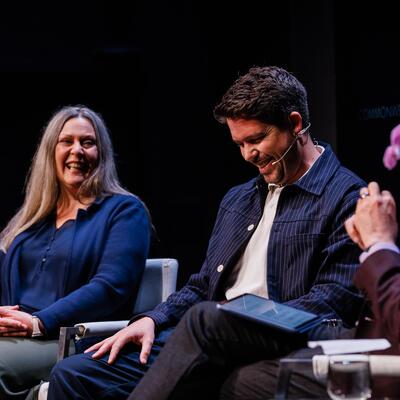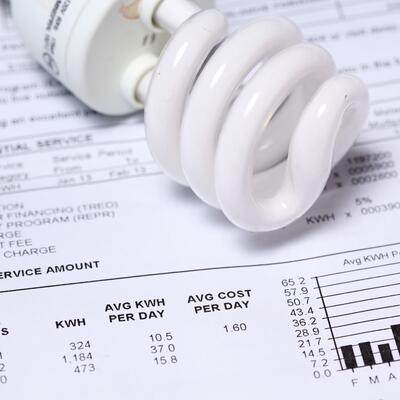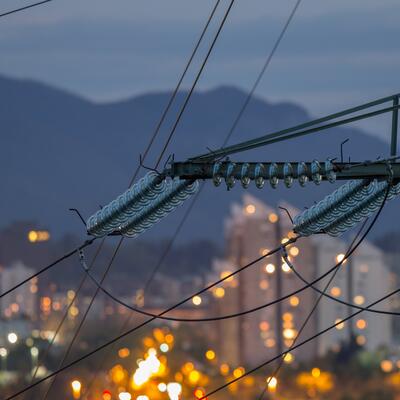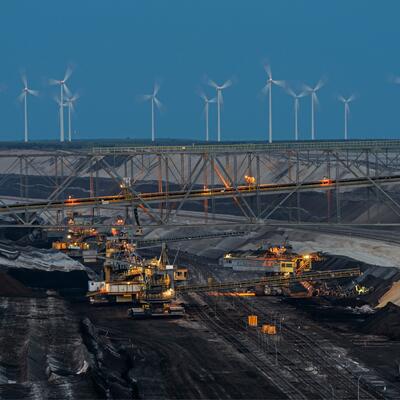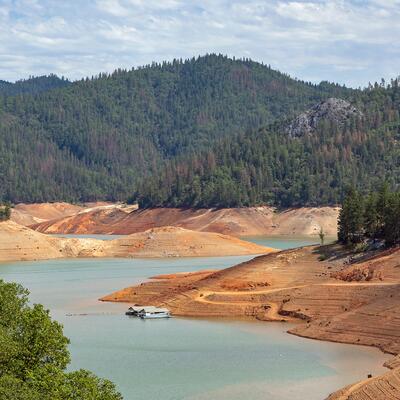
Peter Gleick on Water Poverty, Conflict, and a Hope for the Future
Guests
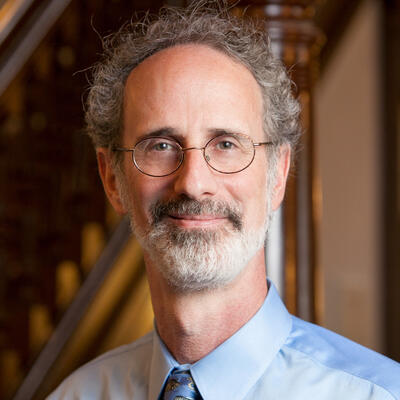
Peter Gleick
Summary
No elemental force has done more to shape life on this planet than water, from originating the earliest forms of life, to sculpting our landscapes, to determining patterns of human civilization. Humans have tried to control water for thousands of years, and access to this precious resource has caused conflict and also unlikely partnerships. In an era defined by climate disruption, the control, access, and quality of water will continue to determine our ability to survive and thrive. How can we ensure a future where clean water exists for all who need it – including the ecosystems we depend on – and navigate the challenges of too little or too much?
This episode includes a contribution from Luke Runyon, Managing Editor & Reporter, Colorado River Basin, KUNC Radio
Episode Highlights
3:00 Balancing agricultural water use with other needs
6:00 Overpumping of non-renewable groundwater
8:30 Defining water poverty
16:10 Violence and armed conflicts associated with water are dramatically on the rise
20:00 Luke Runyon shares excerpts of his podcast “Thirst Gap: Learning to Live with Less on the Colorado River”
39:30 Recent temporary water cuts agreement on Colorado River
46:00 Supreme Court ruling in Sackett v. EPA
51:00 The “soft path” for water and solutions for the future
Resources From This Episode (4)
Full Transcript
Note: Transcripts are generated using a combination of automated software and human transcribers and may contain errors. Please check the actual audio before quoting it.
Ariana Brocious: This is Climate One, I’m Ariana Brocious.
No elemental force has done more to shape life on this planet than water, from originating the earliest forms of life, to sculpting our landscapes, to determining patterns of human civilization. Humans have tried to control water for thousands of years, and access to this precious resource has caused conflict – and unlikely partnerships.
As we enter an era defined by climate disruption, the control, access, and quality of water will continue to determine our ability to survive and thrive. How can we ensure a future where clean water exists for all who need it – including the ecosystems we depend upon – and navigate the challenges of too little or too much?
I’m excited to explore these questions with water expert Peter Gleick, co-founder of the Pacific Institute and author of The Three Ages of Water: Prehistoric Past, Imperiled Present and a Hope for the Future. We spoke at the Commonwealth Club of California in front of a live audience.
As humanity progressed, so did our ability to control water, to the point where we mostly consider ourselves insulated against water shortage or oversupply. AND YET, every year we see examples of how fragile this “control” truly is, especially in our climate-amplified world. Peter Gleick says right now, we're not managing our relationship with water well at all.
Peter Gleick: There are all sorts of climate and water related crises. We take water for granted. And the history of water tells us that we could and should be doing better than we're doing now.
Ariana Brocious: And there are examples in the past of, of doing better, would you say?
Peter Gleick: Well, there's certainly examples in the past of doing better. But in the first age of water, this sort of prehistory, it didn't matter as much. Populations of the planet were very small. We took water where we found it, and we dumped our wastes where, where we could, and it did again, it didn't really matter. Life was pretty miserable anyway, and brutal and short. But those early, that early era of water really helped define humanity. It helped sort of set the stage for where we are today.
Ariana Brocious: And today, and I think this has actually been true for, for quite a long time, about 80% of the water we use goes to grow food. And yet cities are growing. Our populations are growing. We need more and more water. We've seen major advances in irrigation technology, but I would say fewer shifts to less water-consumptive crops, especially in states like my home state, Arizona, where cotton and alfalfa are still mainstay crops. How can we maintain our agricultural economies and food production while using a little bit less water or a lot less water?
Peter Gleick: Well, this is a key of course as you say, 80% of the water that humans use worldwide goes to grow food. That's partly a result of the Green Revolution that happened in the last century where we learned really the importance of irrigated water for agriculture. And, there's a food crisis as well as a water crisis. Hundreds of millions of people go to bed hungry every day today, and populations continue to grow. And the part of the question is, how are we going to continue to grow enough food with the water supplies that are already over tapped? How can we grow more food? How can we meet our needs with less water?
Ariana Brocious: And are there gonna be, I mean, do you think that there's a receptive audience for some of these changes in the U.S.? I mean, just speaking to the US and the amount of power the agricultural lobby has, uh, there's a lot of water that goes to grow things that we don't eat, you know, goes to grow food for cows or food for other animals. Do you see a future where that changes, where we take some of that water for other uses?
Peter Gleick: Well, it depends on who you mean by a receptive audience. In general, people really care about water. If you look at public opinion polls about the environment that have, have gone back for many, many decades, access to safe water and the availability of water and protecting the quality of our water has always been right at the top of those public opinion polls. People care about water. And in terms of changing the way we do what we do…it depends on who we're asking to change and, and what the benefits are. We already see farmers growing more food with less water. When there's a shortage of water, there's pressure on water resources. Then farmers think, well, what can I do differently? How can I do what I want with less water? So we see that in California. We see that around the world. There are changes in irrigation practices now that are moving us in the right direction. But laws and water rights and institutions are sometimes very hard to change and sometimes very slow to change.
Ariana Brocious: We have already seen stretches of U.S. farmland go out of production because wells have gone dry, groundwater wells. Here in California, you know, the pumping has gotten you either too expensive or it's, and also led to ground subsidence. What will happen to these regions when it just becomes impossible to pump any more water? I mean, will, will they recover? Will we see them recover?
Peter Gleick: So this is again, where history sort of is interesting to me. In the first age of water, we didn't think about irrigation. We grew crops once agriculture was invented, where water was reliable, where there was reliable rain, where there were reliable rivers. In ancient Mesopotamia, in the Indus Valley, in India, in China. But as populations grew and as we outgrew those local water resources, we had to think differently about where to get our water. And today, a vast amount of our agricultural water comes from groundwater. Something that was not possible a long time ago. And that really resulted from the Green Revolution. Today, a lot of the crops that we grow are grown with what I describe as non-renewable groundwater. That is we pump groundwater faster than nature recharges it. And like oil, when you pump something faster than nature recharges it, the stocks go down. It becomes harder and harder to find it, it becomes more expensive to use it, and in the long run, it's not sustainable. And that's the agricultural crisis. Today, a substantial amount, maybe 30 or 40% of the world's food production comes from non-renewable groundwater. And it simply can't continue. Groundwater levels are dropping. It's happening in California, it's happening in the Great Plains. Northern China, India. We have to think about how to replace that water, how to grow more food with, with less water. That's again, part of the challenge.
Ariana Brocious: One of the really interesting things I learned from your book is that groundwater pumped from aquifers eventually ends up in the oceans and actually contributes to sea level rise. And this larger point of water being the, the supply is continuous as constant, but we just kind of move it around and in a way we've moved so much of it around in this second age of water, that we've really changed the dynamics. And so can you tell us a bit more about that? Cause I thought that was…that was news to me.
Peter Gleick: Yeah, that's right. So there's renewable water resources. The rivers that flow, the rain that falls, the hydrologic cycle that we all remember from elementary school. And there's non-renewable water, the groundwater resources that have been laid down over thousands or tens of thousands of years. And there are stock there, but when you use them, get used up. When we use groundwater and take groundwater out of that stock and put it on crops, it goes back to evaporation or it runs off back to the oceans. Strangely enough, it contributes a little bit to sea level rise because you're moving a stock from underground into the renewable hydrologic cycle.
Ariana Brocious: Well, so this second age of water is what you define as our current age. And this has been defined by advances in engineering that have essentially re-plumbed the entire planet and brought along unintended consequences, pollution, ecological disruption, conflict, climate change, and then a term that you, you use water poverty. Can you define that for us and, and tell us how that's impacting women and girls around the world especially.
Peter Gleick: So, water poverty is what I mean by that is simply the failure today to provide everyone on the planet with safe water and sanitation and the inequities we see in the way our water systems and institutions have been developed. The second age of water was really an age when we discovered what water was, we discovered what oxygen was and hydrogen and the molecule that makes up water. It was the scientific revolutions that helped us build the water systems that we have today that let us build aqueducts, not a few kilometers long out of dirt as we did in ancient times, but hundreds or thousands of kilometers long and through mountains and build the huge dams that provide water and flood control and drought protection and hydropower. And the smart systems that help deliver to us safe water and sanitation, the things most of us take for granted. You know, the idea that, we can turn our tap and have incredibly cheap, incredibly pure water delivered to us is something many of us in the sort of richer part of the world take for granted. But there are billions of people today worldwide that don't have access to safe water and sanitation. And that's really what I define as, as water poverty.
Ariana Brocious: And even in the US as you said, where tap water is almost always safe to drink, we have under invested in our public water supplies so much so that,though we need to repair and replace most of our infrastructure in the next 15 years, and we don't have really the funds to do it. Has that changed with the infrastructure law and the inflation reduction act and the infusion of money that we've seen from those?
Peter Gleick: It has to some degree. That's another important part about water poverty. You know, we take it for granted that those of us in the wealthier part of the world have safe water and sanitation. But that's true only as long as we invest in our water systems and the disaster in Flint, Michigan a few years ago where a good water system went bad because of underinvestment and mismanagement and the disaster today in Jackson, Mississippi and the communities in the Central Valley that don't have access to safe water still, and the Native American communities that have never had access to safe water in this country. It's not, water poverty is not just a problem in the developing world. It's a problem here, and part of it is the failure to provide safe water and sanitation to those communities. But part of it is, as you say, the failure to continue to invest in the water systems that we have. We're not adequately investing in upgrading and maintaining our urban water systems in most places. That leads to things like Flint, Michigan, and Jackson, the failure in Jackson, Mississippi. The Inflation Reduction Act, passed by Congress and signed by President Biden provides a lot of money for water, provides a lot of money for all sorts of infrastructure in the US, which is great. It provides 15 billion, for example, to remove lead pipes. It provides money for investing in new water systems and upgrading water systems. So it is a step forward. A lot of that money ought to come from our own pockets. You know, we pay water bills, that goes to our water utilities. Those water utilities are responsible for maintaining and upgrading our urban systems. But they haven't been maintained the way they ought to be.
Ariana Brocious: Well, this is one thing you also write about in the book, this sort of necessity that you argue to continue investing in our public water supplies as opposed to privatizing them. Can you explain that argument and maybe the problems that might come from privatization of water?
Peter Gleick: And that can be defined in a lot of different ways. Bottled water is a way to privatize public water systems as well. In the US most of our public water agency or most of our water utilities are public. And they've always been public. A small fraction, maybe 15% are, are private. But there was a trend of a little more than a decade ago, there was this belief that because of problems with public water agencies that maybe we should turn them over to private entities. And the World Bank was arguing in developing countries we should let private companies run water agencies because public agencies and governments had been a failure. There was a lot of opposition at the time. There were riots in Cochabamba Bolivia about an effort to privatize the water system in Bolivia and people died in those riots. And at the same time, there were a number of public water agencies that saw the threat of privatization and realized that one way they could maintain public control was to improve their operations. And it turns out a well-run public water agency is just as good as a well-run private water agency, and rates tend to be lower for public water agencies and there are no profits really, those monies are reinvested in the public system. And so there is still pressure in some places to privatize water systems. But I think the lesson that we've learned is that a well-run public agency is a better idea.
Ariana Brocious: So we talk on climate one about the individual and the systemic and ways people can have agency and I'm curious if there's a water intersection here. I mean, as somebody who pays water bills, is there something you can do to kind of keep your utility working for you?
Peter Gleick: Well, yes, in fact, you know, most water utilities are sort of a mystery to most people. They again, they turn on their tap and they get clean water and they pay their water bill. And there's not a problem until there's a problem. But public water utilities are public. They have boards of directors and members of the public can run for boards of directors and people can go to meetings at their public water utilities or their private water utilities and they can participate. It's always better not to wait until there's a crisis to get involved.
Ariana Brocious: You mentioned tribes as being one of the groups that doesn't always have great access to water. And in the Southwest particularly tribes hold some of the oldest water rights, and they've also been ignored in discussions of water management, like on the Colorado River and left without access to clean, plentiful water. I think the Biden administration has been working to address some of these wrongs, and I'm curious if you think we've seen any significant changes yet, or maybe some that are to come with these new investments, for tribes specifically.
Peter Gleick: Well, this is a total contradiction in terms in many ways water rights in the west have been given out under something called prior appropriations. First in time. First in right. If you were there first, you were the first farmer to take water out of a river. You had to hire a more senior water right, than somebody who came along later. And that first in time, first and right rule, it defines water rights in the Western United States, and yet the tribes who really were here first obviously tend not to have senior water rights. They were excluded from those early water rights allocations. There has been an effort in recent years to change that. There have been court cases in recent years that have reallocated some rights back to the tribes. And it is an opportunity to redress, to address and, and reverse some of the wrongs that were done over the last couple of centuries in the West. But a lot more needs to be done in that area.
Ariana Brocious: So one thing that I think is common in the popular imagination when you think of water is water wars, right? And in the book you write that so-called water wars are “improbable, unlikely, and historically rare. But violence and armed conflicts associated with water are unambiguously and dramatically on the rise.” So can you unpack that for us?
Peter Gleick: Sure. This is something I've worked on for a long time. At the Pacific Institute, we maintained something called the Water Conflict Chronology, which is an open source database of conflicts over water throughout history. We don't have wars over water. Wars start for a lot of reasons. Wars start for economic reasons, ideological, religious, political conflicts over borders, economic reasons. But we do increasingly see violence associated with water resources in three forms. We see water as a trigger of conflict where there's a dispute over access or control of water. We see water or water systems used as weapons during wars. And we see water as a casualty or water systems as casualties of conflicts. Again, conflicts that may start for other reasons. And we recently did an analysis of the data in the water conflict chronology and data in history that shows that the number of conflicts over water have increased very dramatically in recent years, in part because of growing pressure over scarce water resources, in part because of a number of conflicts where civilian water systems have been targeted. But that's, that's the way I think about water and conflict.
Ariana Brocious: And how do we get around that? Is that part of the idea of just ensuring everyone has access to water? I mean, they could still be a casualty of war, I suppose.
Peter Gleick: Well, there are lots of ways around it. Part of the challenge is meeting basic human needs for water. If everyone has access to safe water and sanitation, if everyone has control of water resources in their communities, water is less likely to trigger violence and conflict. And we see a lot of conflicts now where there's disputes over control and access to water. International law plays a role in this. International humanitarian law is very explicit saying that civilian infrastructure should be protected during conflicts, including very explicitly water resources. Institutions have a role to play, better institutions to manage water when it crosses a border, and most rivers worldwide cross borders. And so institutions that can manage trans-boundary water resources are an important part of that puzzle as well.
Ariana Brocious: You’re listening to a Climate One conversation with water expert Peter Gleick. Our podcasts typically contain extra content beyond what’s heard on the radio. If you missed a previous episode, or want to hear more of Climate One’s empowering conversations, subscribe to our podcast wherever you get your pods.
Please help us get people talking more about climate by giving us a rating or review. You can do it right now on your device. You can also help by sending a link to this episode to a friend. On our new website you can create and share playlists focused on topics including food, energy, EVs, activism.
Coming up, how we got to our current crisis on the Colorado River:
Luke Runyon: The challenge of balancing the health of the river and our own needs has reached a precipice. All the science says the river is getting smaller. Which means our demands for water will have to shrink as well.
Ariana Brocious: That’s up next, when Climate One continues.
Ariana Brocious: This is Climate One. I’m Ariana Brocious, and we’re talking about water – shortage, conflict, and sustainable ways forward. We’ll come back to my conversation with Peter Gleick later in the show. But first, we’ll dive into one major watershed in particular, the Colorado River, with Luke Runyon, an editor and reporter with KUNC, the NPR station in northern Colorado. Luke recently released a 6-part podcast series that takes listeners from the Colorado River’s headwaters all the way to its depressing terminus in the desert of Mexico, and along the way he explains how this vital water source has been overused and what’s happening now that it’s getting dry. The series is called “Thirst Gap: Learning to Live with Less on the Colorado River,” and I highly recommend listening to the whole thing. Today we’re going to hear a few excerpts from the show to give us a sense of what’s happening on the river, and how we got here. Here’s Luke:
Luke Runyon: I’ve been covering water issues along the Colorado River for the last five years. I’ve seen the conversation change from “we should probably be worried about this” to “we’re getting a little more worried about this” to right now when the conversation sounds more like “this is a crisis spiraling out of control.”
The Colorado River is truly astounding. It’s the kind of natural wonder that inspires those over the top, old-timey government promotional videos...
ARCHIVAL TAPE: “Of all the rivers in the world, the Colorado is one of the most beautiful and most useful.”
Luke Runyon: You can see the river best from an airplane. A few years ago I flew the length of it in a tiny Cessna. And I remember gawking out the window flying from Colorado to Mexico seeing just how arid the southwest is.
ARCHIVAL TAPE: “This river drains nearly a quarter of a million square miles of land, including parts of seven states...”
Luke Runyon: Deserts sprawl on either side of this thin blue thread that weaves its way through. Everything from massive cities to farms to plants and wildlife, all dependent on this relatively small, desert river. The challenge of balancing the health of the river and our own needs has reached a precipice. All the science says the river is getting smaller. Which means our demands for water will have to shrink as well. And we’ve created a lot of demands. In fact 40 million of us, about 1 in 10 Americans rely on this shrinking water supply. That includes giant cities like Denver, Los Angeles, Phoenix and Las Vegas. Sprawling agricultural regions, like California’s Imperial Valley, or the fields of romaine lettuce around Yuma, Arizona. Which means even if you don’t live in the southwest, you probably eat the things that are grown here, irrigated by the Colorado River.
ARCHIVAL TAPE: “Melons! Another crop that thrives in Imperial Valley. These cantaloupes are shipped in refrigerator cars to markets all over the United States. Yet, only cactus and lizards could survive here without the Colorado water.”
Luke Runyon: Finding a way to live with less water isn’t easy. Conversations quickly turn to finger-pointing. Whose use of water is justified? And whose isn’t? And what are we willing to give up -- to sacrifice -- in order to bring our supply and demand back into balance? Those tradeoffs, that’s what I’m most interested in for this series. Because delving into those choices, that’s the conversation the southwest is going to be having for a while.
Ariana Brocious: Many westerners know that there is more Colorado River water on paper than there is in the river–because 100 years ago, when a bunch of white men divvied it up, they knowingly gave out more water than there really was. For a long time it didn’t really matter, but in recent years the Colorado River’s flows have dropped by one third, due to a combination of drought, climate change, and population growth. Eighty percent of the river goes to agriculture, and so as shortage occurs, many look there first for water savings. One of Luke’s first stops is western Colorado’s Grand Valley, where he meets with father/son farmers Troy and Calvin Waters. Yep, their last name is Waters.
Luke Runyon: Troy and Calvin run this farm together. It’s about 600 acres. Their biggest crop is seed for alfalfa hay. But Troy says they like to experiment.
T. WATERS: Waters Farms has pretty much raised about anything you can try raising here in the lower valley: Forage alfalfa, corn, soybeans, pinto beans, barley. Tried a little popcorn one time. That was interesting.
Luke Runyon: Part of the farm sits within an irrigation district that pulls water directly from the Colorado River miles away. That water flows by gravity down here. It’s then Troy and Calvin’s job to make sure the water makes it to each individual plant. The canal system is old, and when it comes to water rights, you want them to be old.
T. WATERS: Traditionally we're sitting here in this valley with some of the oldest water rights on the Colorado River. We've always had plenty of water. Even though we're hot and dry, we can irrigate the crop when it needs it, not dependent on Mother Nature, you know, to get timely rains, and I think that’s what makes us really unique.
Luke Runyon: Let me give a quick rundown of how water rights work. It’s basically a legal system meant to manage scarcity. And it’s all based on time. When did someone first put some amount of water to use. The older the right, the more protected it is. And it can be passed down through generations like a family heirloom. Senior users get their full share before anyone else, meaning farmers, some of the region’s first white settlers, often hold the oldest, and therefore most valuable rights in the West. Still, Troy says he’s felt an increasing pressure to use less.
T. WATERS: There's been more and more talk every year about conserving water, keeping more water in the river and I'm all for that. I'm all for conserving water. I'm all for -- water is our most precious resource. And we need to protect it. And we need to utilize it the best way and manage it the best way possible.
Luke Runyon: Around the year 2000 it seemed a switch was flipped in the Colorado River basin. Droughts started to feel less like a temporary problem and more like a permanent change in how the river functions -- hotter, drier, and less water to go around. In response to that decreasing supply, the federal government, some large cities in the West and environmental groups turned their attention to agriculture. And some ideas on how to get farmers to use less without going out of business began to gain momentum. What would it take for farmers, with their more protected water rights, to conserve? A few different programs were rolled out. They essentially all have the same mission -- see if you could pay farmers enough money to leave some of their fields unplanted, and keep the water they were legally entitled to in the river instead of flowing over farm fields. Troy is on the board for his irrigation district and when the opportunity to join some of these programs came up –
T. WATERS: There were some very, very long meetings and lots of arguing and yelling, when we first started talking about that. And I'll admit I was totally against it from day one, doing any of these programs. And to me it didn't make any sense in my mind leaving productive agriculture land sit vacant. We have spent 100 years turning desert ground into productive ag ground. And when you don't irrigate it, you're going backwards.
Luke Runyon: Troy wondered if he was sacrificing, who was benefitting? Big cities and farms downstream in California? It didn’t sit right with him. Ultimately, he saw some value in trying it as an experiment.
T. WATERS: Me and my son talked about it and we decided, I told him, ‘Hey, maybe we need to participate just to see...’
C. WATERS: How we can make this work on our operation into the future.
T. WATERS: If, if, if push comes to shove and we were forced to. Everybody keeps saying demand management should be voluntary, temporary, and compensated. Them are the three big words. Well my fear is that it ain’t going to be voluntary. My second fear is it ain’t going to be temporary. And I can guarantee it ain’t going to be compensated good enough. We need to try it to see if we're forced to in the future, how we could implement it on our farm? How would it affect us? I had my feelings for what it would do to our ground. I wanted some proof. And like I said, I was the biggest naysayer on the board against it. I don't feel that you can sit back and be a naysayer and against something unless you actually got experience.
Ariana Brocious: As that episode continues, we hear how the Waters men struggled with the idea of leaving their land vacant, and watching it turn back to desert without regular irrigation. And their worries that on a large enough scale, these kinds of programs will impact where our food is grown. But they also discovered that a private equity company was buying up land around them along with the water rights. In the larger region, there’s continued interest in paying farmers not to use water, either temporarily or more permanently. The Inflation Reduction Act includes hundreds of millions of dollars for this very purpose. But it remains a controversial idea within agricultural communities, even as levels in Lake Mead and Lake Powell – the reservoirs on the Colorado River – drop lower and lower. As Luke explains while hiking through Glen Canyon, which was dammed and flooded in 1964 to create Lake Powell, some say the river’s flow has dropped so much that we don’t need both reservoirs anymore.
Luke Runyon: Today, our guide is Eric Balken. He runs the Glen Canyon Institute, which advocates draining Lake Powell and moving what’s left of its waters downstream. As we hiked we saw artifacts of when this side canyon used to be inundated by Lake Powell. We walk past a sunken speedboat, pairs of sunglasses, and a lifejacket. And through ghost forests of dead cottonwood trees, frozen in time at the bottom of the reservoir since the 1960s, and only recently reemerged. Eric pointed out a high water mark from the reservoir stained on the redrock a hundred feet above our heads.
BALKEN: There's so much plant life. There's these forests of willows, birds and bugs and life just humming around us. There are a lot of big changes coming to the Colorado River. And this is one that's a good change. You know, to see this canyon comeback is really special. And in looking at the decades ahead I just don’t see Glen Canyon playing the role of water storage that it did in the previous decades.
Luke Runyon: Environmental groups like Eric’s want to see Lake Powell’s dam decommissioned and the entirety of Glen Canyon behind it restored. He says this current moment of reckoning on the river, where users are collectively trying to figure out how to rely on it less, should be seen as an opportunity.
BALKEN: I think our vision for Glen Canyon is to see it be restored to its full potential. I don't want to say restored to what it was before the dam, because it’ll never be exactly like it was before the dam. But we've seen inside canyons like this that it can get really close and the restoration process happens very quickly. And what's coming back is amazing, and so we know there’s so much potential for restoration here, and the vision is to just maximize that. From a policy perspective, it means that we should prioritize water storage elsewhere. We should stop thinking about Glen Canyon as a place to store water and start thinking about it as a place that has natural values, intrinsic values, values that are similar to other parks around us.
Luke Runyon: His vision includes moving all of the water from Lake Powell to its downstream sister reservoir, Lake Mead. Both are currently at record lows. It would take some reengineering of Lake Powell’s dam to make it happen. That kind of thinking used to be considered fringe and the suggestion of draining Lake Powell, taboo. Now, Eric can make a case that it’s hard-nosed pragmatism.
BALKEN: There's just not enough water to fill up both of these massive reservoirs anymore. And there's a real serious question of how much storage does the basin need. But in our new dry reality that we live in, it's not needed for that because we don't have enough water to fill them up. And if we, you know, can acknowledge that Glen Canyon Dam was this massive environmental mistake, why are we still clinging to it? Why are we still accepting that mistake? Let's give it a chance to come back to life.
Ariana Brocious: While climate disruption has been decreasing the amount of water in the river, the 40 million people who rely on it have done a better and better job of using less. In fact, it’s been remarkable how much the West’s population has grown with the same amount of water. That’s thanks to tons of water conservation and crackdowns on water excess in cities like Phoenix and Las Vegas. But one place that’s never had equal access to this essential resource is the Navajo Nation, where about one third of people lack running water in their homes. As Luke explains, in spite of the fact that Indigenous people lived in this region long before anyone else, and that they own significant rights to the Colorado River’s water, tribes have been excluded from nearly every major agreement on the river over the last century. And part of the future calculus for the river means actually including tribes and their water needs in the overall picture. Some of this played out in a recent Supreme Court Case, Arizona v Navajo Nation.
Luke Runyon: The facts in this case reach back as far as 1868 when a treaty between the tribe and the U.S. government established the reservation. And at its core, the case is about what duty the federal government has in helping the Navajo, or potentially any other tribe in the Colorado River basin, to develop, and eventually use its water rights. The feds say the agreement provided the tribe with a “bundle of sticks,” meaning it gave certain rights to natural resources – timber, minerals and water. But it didn’t force the government to help the tribe make best use of those sticks. The tribe says the government is duty-bound to help secure the water, and should help assess and plan for their future needs. Realizing the cost that could come with that duty, the government says it doesn’t. The Navajo Nation’s lawyer, Shay Dvoretzky, framed the dispute as one more broken promise in a long history littered with them.
DVORETZKY: In the 1868 treaty, the United States promised the Navajos a permanent homeland. Both parties understood that in promising the Navajos their land, the United States was also promising them the water it needed to sustain life in the arid southwest. Those treaties are specific sources of law that give the Nation rights to water and impose duties on the government to secure that water. But for years, the United States has failed to fulfill that promise.
Ariana Brocious: In late June, the Supreme Court released its ruling in favor of the U.S. government in a 5-4 decision. Writing for the majority, Justice Brett M. Kavanaugh said the 1868 peace treaty did not require the federal government to take “affirmative steps” to secure water for the Navajo. Justice Neil M. Gorsuch and the court’s three liberal members dissented, writing that the government had violated the terms of the treaty. This case came to the court at a time when the Colorado River is getting unprecedented national attention, and concerns about how much water the tribe might use adds to existing uncertainty about water supply. And yet, Crystal Tulley-Cordova, a principal hydrologist for the Navajo Nation Department of Water Resources, says tribal leaders still don’t have an equal seat at the negotiating table alongside the seven U.S. states that rely on the river.
TULLEY-CORDOVA: If we thought that everything would be equitable, that we are there, we're not there. Because tribes are not, were not signatory, are not signatory to operations of the reservoirs in the Colorado River basin. But we are more included now than we ever have been in the past.
Luke Runyon: Involving tribal voices and perspectives in all future agreements is one way to begin to ensure the river’s water is distributed fairly and justly. Even Crystal says that won’t be easy. The Navajo Nation is one of 30 tribes in the Colorado River basin. Each tribe has a unique cultural and spiritual relationship to the river and its many tributaries. Each tribe has its own unique economy. And each has its own water needs.
TULLEY-CORDOVA: I think with the Colorado River Basin, the challenge is that many people think that things are etched in stone. And when you have that mentality of things that are etched in stone, it's like, ‘Oh, things are not able to change from the past.’ And it's thinking like, ‘Well, it's worked the past 100 years. It should always work.’
Ariana Brocious: The Colorado River used to flow all the way to the Pacific Ocean. But because it’s so heavily tapped in the U.S., today it comes to an end in an irrigation canal at the U.S.-Mexico border. The river’s final hundred miles have been mostly dry for decades–a possible prediction of what more of the basin could look like without major concessions on all sides to better share a diminishing Colorado River. Discussions for new water sharing agreements among the states, tribes, and Mexico are beginning, with significant pressure to agree on more permanent cutbacks to keep this vital resource alive into the future. Big thanks to Luke Runyon of KUNC for sharing excerpts from his series “Thirst Gap” with us. Johanna Zorn is Thirst Gap’s editor and Jason Paton is sound designer. You can find the whole series wherever you get your podcasts. Give it a listen, I highly recommend it.
Ariana Brocious: Coming up, reframing our relationship with water to prepare for a more sustainable future:
Peter Gleick: The realization now that we ought to think about how much water is available before we decide what to build and where to build it, is a step forward. It’s a radical step forward.
Ariana Brocious: That’s up next, when Climate One continues.
Ariana Brocious: This is Climate One. I’m Ariana Brocious. Let’s get back to my conversation with water expert Peter Gleick, recorded in front of a live audience at the Commonwealth Club of California. Climate, drought, and population growth have cut the Colorado Rivers flows by about one third in recent years and dropped its reservoirs to historic lows. Recently after months of negotiations, California, Arizona and Nevada agreed to take cuts equivalent to about 13% of their part of the river. They did that rather than having the federal government step in and decide those for them. These actions should temporarily spare western cities and farms from having their taps run dry. But it is a short term solution only. I asked Peter Gleick, a Californian, about his view on this deal and the longer term outlook for this essential water supply.
Peter Gleick: I don't think that the agreement that was reached with about a month ago, I guess, really is going to be sufficient to address the problems on the Colorado. I think it might result in a short term, a little bit of breathing space. Uh, but the problem really, like much of the water in the Western United States, like much of the water and rivers are around the world, is simply over-allocated. We use more water than nature can reliably provide. Until we get water demand under control, there's not much that you can do to reduce the conflicts on the Colorado, we simply demand more water than nature provides.
Ariana Brocious: And so by reductions of demand, I mean we've already dropped our water use dramatically from what it used to be. I know you can cite a figure probably better than I can on that, but,we still have farther to go, basically, or get people to move back east instead of out west.
Peter Gleick: So we haven't cut demand on the Colorado that much. And the, and the cuts that we've seen on the Colorado are temporary. They're in response to the shortages that we see. But I think most traditional water politics assumes, oh, these shortfalls are temporary, and we'll figure out how to find more supply. The climate will change again, and, and we'll get wet years on the Colorado. We had sort of a wet year this year on the Colorado, and the reservoir levels are gonna go up a little bit. I think that's temporary. Or we'll build a pipeline from the Mississippi River or we'll desalinate water in the Gulf of California and pump it up to the Colorado River. There's this old, old style thinking that will solve our water problems with the approaches that we used in the 20th century and in what I describe as the second age of water in the book. And I don't think that's gonna be enough.
Ariana Brocious: And then how do we get demand under control?
Peter Gleick: There are lots of ways. One is, we use water more efficiently. We use better irrigation systems. We use better technologies in our industry and our commercial and residential water use to cut our water use to do the things we want to do more effectively. And that's really important and we've done a lot in that area. And it's cut our water demand a great deal. But ultimately in the Colorado, and I think in parts of California, we're gonna have to change what we grow and where we grow it. On the Colorado, 80% of the water also goes to agriculture. The vast majority of that water goes to grow crops that are fed to animals to produce meat. Again, this is true worldwide as well. A lot of the food that we grow never is consumed by humans, but goes to feed animals. There's gonna have to be a fundamental change in people's diets, in what we choose to grow and where we choose to grow it. I think we're gonna have to cut how much land is irrigated. Not just what we grow, but how much land is irrigated in the Colorado. And I think that's gonna be true in parts of California.
Ariana Brocious: So to that point, about 1.2 billion from the Inflation Reduction Act is going to be used to pay cities, tribes, and farmers to temporarily use less water. But that money will run out and the water needs will continue. In some places, you're saying we can fallow the land and not use it anymore. When are we gonna get to that point where farmers are gonna willingly be bought out so that we can use the water for other things?
Peter Gleick: Yeah, this is a really good point. The agreement that was reached a month ago or so, to reduce water use in California and Arizona and Nevada, the southern basin states on the Colorado was in part encouraged by a big contribution from the federal government, 1.2 billion. I've been arguing that that money ought to go to permanent reductions on the Colorado. Not temporary cuts to meet shortfalls over the next couple of years, but to invest in better irrigation systems, permanent improvements in irrigation systems or urban water use to buy out farmers permanently. I don't think that's gonna happen yet, but ultimately something is gonna happen to get farmers to cut their water use, either voluntarily or by mandatory reductions imposed by the states.
Ariana Brocious: Arizona just announced it's going to stop developers from building some new subdivisions around Phoenix because the state has determined there is not enough groundwater to support it. Phoenix has been booming, especially some of these metro areas, kind of on the outskirts. There is still a lot of development happening, but this is kind of the first step it would seem in recognizing maybe that there is actually a limit. Do you agree? Do you think we're gonna see more of that?
Peter Gleick: Yeah. So one of the, one of the challenges I just discussed in the book is the failure to think about water resources and economic development in a sustainable fashion is the best way I can describe it. We've always assumed that we could develop wherever we wanted and whatever we wanted, and ultimately we would figure out how to provide the water and the energy and the food. That's simply not true any longer. It hasn't been true for a long time. In the southwestern part of the United States and in parts of California, we are running up against absolute limits to how much water is available to us and the decision, finally, perhaps one could say, to think about long-term land use planning and development in the context of how much water is available is a step forward. It's a difficult one. Developers have driven this for years. But the realization now that we ought to think about how much water is available and how much energy is available and how much food is available before we decide what to build and where to build it is a step forward. It's a radical step forward.
Ariana Brocious: So, pivoting just a bit, the recent Supreme Court ruling in Sacket versus EPA dramatically limited the scope of the Clean Water Act, removing about half of the nation's wetlands from protection from contamination. That there kind of sums up the result that's really significant. What do you think the impact is going to be from this on our freshwater resources and what, if any, remedies do we have to, to sort of fill in the gap?
Peter Gleick: So I am an optimist. I believe we can solve our water problems. That's not to say, say there won't be steps backwards. And the recent decision by the Supreme Court to strip protections from a vast number of wetlands in the United States is a step backwards, a terrible step backwards, that ruling. I'm not a lawyer, but I will go so far as to say it wasn't justified by the law. It's not justified by ethics, it's not justified by any aspect of environmental science. It was a step backwards. I can't help but hope and think that in the long run, protections for wetlands will be reestablished. We have a growing understanding of the incredible importance of ecosystems for our own wellbeing. The incredible importance of wetlands for fisheries, for water quality, for migratory birds, for every aspect of, of the environment. But there will be steps backwards on this, this path that I hope will lead us forward.
Ariana Brocious: But as a water expert, isn't it just confounding that there's this sort of like disconnect between the science of understanding that groundwater and surface water are connected and a ruling that sort of says they aren't, or that it's not significant and enough to matter?
Peter Gleick: Yes, scientifically it was a completely illogical, ridiculous decision, but the decision wasn't made on the basis of science is maybe the politest thing I can say about that. As a scientist, I would like to think that our policies, our politics, our economics would be based on fact. They aren't always, and that's a sad reflection on where we are today. It's partly why the second age of water has a series of water crises. The failure to provide safe water and sanitation isn't because we don't know how to provide safe water and sanitation. It's because of a failure of economics and politics and institutions. The failure to clean up our water resources isn't because we don't know the importance or how to do so, but because of the failure of politics and economics and our institutions.
Ariana Brocious: Well, let's go into the third age of water, which is your vision for a more hopeful future. And as a step, hopefully toward that, in 2010, the UN General Assembly formally recognized the human right to water and sanitation. In the last decade. What progress has been made on this goal to ensure all humans have access, have a right to clean, safe water?
Peter Gleick: So the failure to provide safe water and sanitation to everyone isn't a, it's not a new problem. It's not an unknown problem. A lot of money, a lot of effort is being put into providing safe water and sanitation for everyone. The UN declared a human right to water in 2010, as you said, that, that helped. It's a declaration. It doesn't by itself provide anybody with safe water and sanitation, but it was an indication of the growing awareness that water poverty was a problem and that we needed to do more to meet those objectives. But even here in the United States, you know, we haven't met that need for everyone. So we are making progress and I'm optimistic that in the long run, maybe not by 2030, but in the long run, we will provide everyone on the planet with safe water and sanitation. I'd like to think that it's inevitable.
Ariana Brocious: So at the end of the book, you paint a possible future, very utopian, very optimistic about how we've sort of solved a lot of these problems. So I wanna invite you first to explain your proposal for the soft path of water and what that would mean.
Peter Gleick: I think we're at a turning point in history actually around water and many other things. The dystopian future, which is the one we hear about a lot in daily newspapers and in, in the movies that we see and, and in the story science fiction stories about dystopian futures. That's the common future that we all understand is possible. But what I describe in the third age of water is not that future, it's the alternative future. It's the positive vision that I think is not just possible, but also I think inevitable. And I think it's inevitable because I see all around me success stories. I see the declaration of the human right to water. I see farmers growing more food with less water. I see urban water use going down in the United States, even though our economy and our population continues to grow. I see the success stories, the things that we need to do. What I ultimately describe as the soft path for water in the book. And the soft path basically says, We can rethink water supply, which used to mean taking more water out of groundwater and out of our rivers, and over pumping our, our wetlands and our ecosystems. And we can find new sources of supply that don't require doing that highly treated wastewater. Which we're starting to use in California and that they use extensively in Singapore and Israel and other places. So rethink supply is one, rethink, demand again, the assumption that we can grow forever and meet demands, growing demands for water is no longer valid, but that we can use water more efficiently. That's demand management and water use efficiency. And again, we use less water for everything in the United States today than we used 40 years ago. We are changing the demand for water and the soft path says, stop ignoring ecosystems again. In the second age of water, we didn't understand or we didn't know the consequences of our water use for the natural environment, but we do today and we can no longer ignore natural ecosystems. And we're starting to restore natural ecosystems and we're guaranteeing river flows and we're taking down the most damaging dams. And so the soft path says, think about ecosystems, not just economics. And the soft path says, rethink our institutions. We need institutions for the 21st century, not institutions that we built in the 19th century and the 20th century that didn't understand the way we need to rethink the way we use water. And all of those together are the soft path for water. And those things together are what give me hope that we can reach that sustainable future.
Ariana Brocious: Well, as we close here, I just want to share a little bit of my water connection. So I'm from Tucson, Arizona, and our river that flows through town, is the Santa Cruz River, one of them. And that's where Tucson was founded. Way before there were Spanish conquistadors that came through. That was the site of indigenous people that lived there for, I think it's one of the oldest, continuously cultivated parts of the whole United States. And my entire life, that river has been dry. I mean, we call it a river, but it's just an empty dry river bed. And a few years ago, the local water utility began putting highly treated wastewater back to recharge the groundwater table there. And it has created this little oasis that's really beautiful and there is a multi-use path along the river. There are dragonfly populations, there are frogs, there are birds that come. And it's really a short stretch of river. It's not long, but it's really amazing to have water back in this place where it should have been, if we hadn't overpumped. So I say all of that to ask you, is there a place like that that you can think of that's special to you and that you've maybe seen go through changes and you're still optimistic about?
Peter Gleick: So that's a wonderful story. And it's an indication, first of all, about how much people care about water. And it's an indication that we can restore some of the damages that we did in the second age of water, which is our age. My wife and I we're both bird watchers. We love in the winter in California to go up to Northern California to the wildlife refuge where literally hundreds of thousands and millions of birds winter, or they come down from, from the Arctic and from Canada, and they spend the winter in California. But they're incredibly dependent on the wetlands in Northern California that for years have been dried up. The wetlands have been shrinking, the rivers have been shrinking. The farmland has paved over a lot of the wetlands there. But in recent years, we've seen a restoration of some of those wetlands. In the winter, many of the farmers in the northern part of the Central Valley flood their lands, which actually is beneficial for the farmland themselves, but it restores wildlife and wetland habitat for migrating birds. And it's just wonderful in the winter now to go up and see thousands and thousands of acres of wetlands being restored and millions and millions of birds. And it's good for the soul and it's good to know that we're moving along this path.
Ariana Brocious: Well, thank you. Peter Glick is co-founder of the Pacific Institute and author of “The Three Ages of Water, prehistoric Past Imperiled Present, and a hope for the future.” Peter, thank you so much for joining us on Climate One.
Peter Gleick: Thank you very much.
Ariana Brocious: Climate One’s empowering conversations connect all aspects of the climate emergency. Climate One’s empowering conversations connect all aspects of the climate emergency. To hear more, subscribe wherever you get your pods. Talking about climate can be hard-- AND it’s critical to address the transitions we need to make in all parts of society. Please help us get people talking more about climate by giving us a rating or review. You can do it right now on your device. You can also help by sending a link to this episode to a friend. On our new website you can create and share playlists focused on topics including food, energy, EVs, activism. By sharing you can help people have their own deeper climate conversations.
Greg Dalton is our host and executive producer. Brad Marshland is our senior producer; Our managing director is Jenny Park. Ariana Brocious is co-host, editor and producer. Austin Colón is producer and editor. Megan Biscieglia is our production manager. Wency Shaida is our development manager, Ben Testani is our communications manager. Our theme music was composed by George Young (and arranged by Matt Willcox). Gloria Duffy is CEO of The Commonwealth Club of California, the nonprofit and nonpartisan forum where our program originates. I’m Ariana Brocious.
